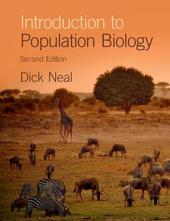
|
Introduction to Population Biology
Paperback / softback
Main Details
| Title |
Introduction to Population Biology
|
| Authors and Contributors |
By (author) Dick Neal
|
| Physical Properties |
| Format:Paperback / softback | | Pages:460 | | Dimensions(mm): Height 243,Width 188 |
|
| Category/Genre | Ecological science |
|---|
| ISBN/Barcode |
9781107605121
|
| Classifications | Dewey:577.88 |
|---|
| Audience | | Tertiary Education (US: College) | |
|---|
| Edition |
2nd Revised edition
|
| Illustrations |
4 Maps; 33 Halftones, black and white; 188 Line drawings, black and white
|
|
Publishing Details |
| Publisher |
Cambridge University Press
|
| Imprint |
Cambridge University Press
|
| Publication Date |
29 November 2018 |
| Publication Country |
United Kingdom
|
Description
How do plant and animal populations change genetically to evolve and adapt to their local environments? How do populations grow and interact with one another through competition and predation? How does behaviour influence ecology and evolution? This second edition of Dick Neal's unique textbook on population biology addresses these questions and offers a comprehensive analysis of evolutionary theory in the areas of ecology, population genetics, and behaviour. Taking a quantitative and Darwinian perspective, Neal uses mathematical models to develop the basic theory of population processes. Key features in this edition include new chapters on inbreeding and species interactions and community structure, a modified structure in Part II, more recent empirical examples to illustrate the application of theoretical models to the world around us, and end-of-chapter problems to help students with self-assessment. A series of spreadsheet simulations have also been conveniently located online, for students to further improve their understanding of such models.
Author Biography
Dick Neal is Professor Emeritus at the University of Saskatchewan, Canada, having taught undergraduate ecology for almost forty years. His thesis on Ugandan rodents was conducted at the Nuffield Unit of Tropical Ecology in Uganda, and he continued this research on the breeding of African rodents with sabbaticals in National Parks in Kenya (1974-5) and Zimbabwe, (1987-88, 1990). Other research areas have included the impacts of uranium mine effluent on aquatic ecosystems; effects on the structure and function of plankton communities; and the bioremediation of contaminated pits.
Reviews'Neal's book is a masterly synthesis of evolutionary biology and ecology that integrates recent developments in both fields and explains their biological significance. An ideal starting text for students of organismal biology.' Tim Clutton-Brock, University of Cambridge 'This is by far the best textbook produced so far that combines evolution, ecology and population genetics. A thorough theoretical analysis suitable for advanced-level undergraduates. Fully recommended.' Anthony R. E. Sinclair, University of British Columbia
|